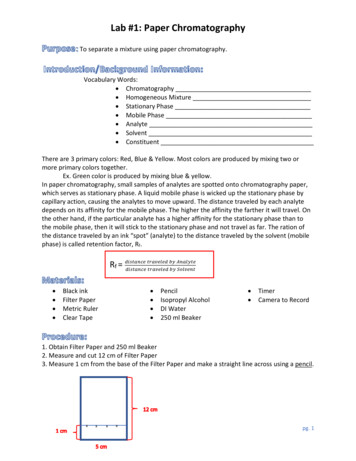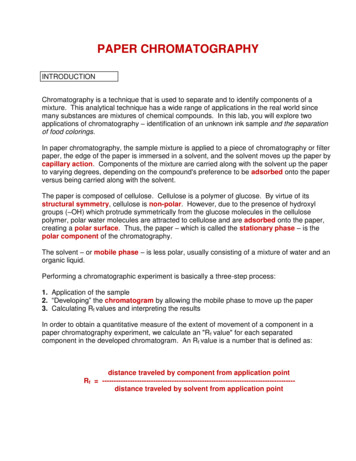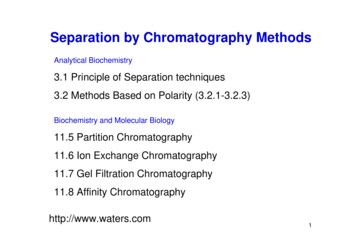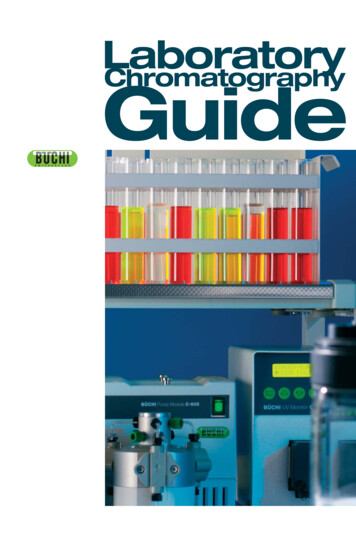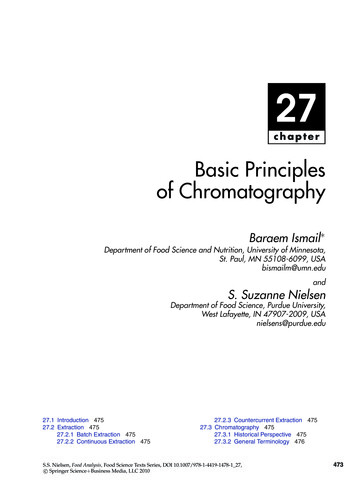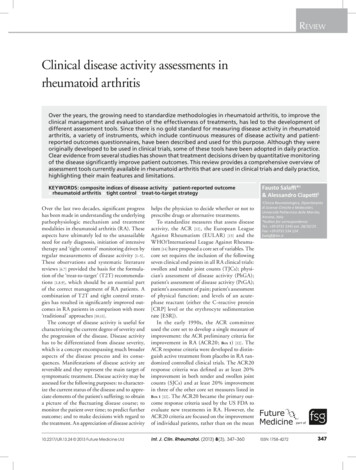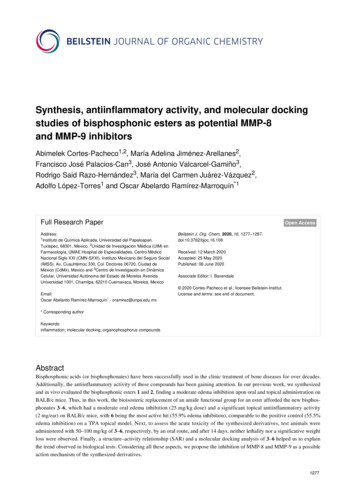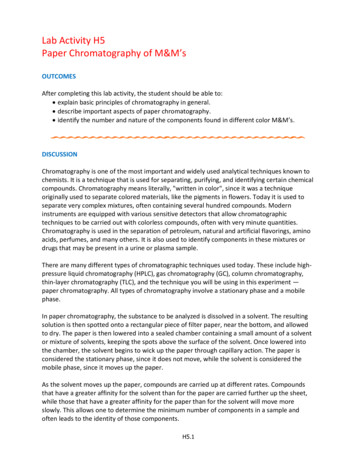
Transcription
Lab Activity H5Paper Chromatography of M&M’sOUTCOMESAfter completing this lab activity, the student should be able to: explain basic principles of chromatography in general. describe important aspects of paper chromatography. identify the number and nature of the components found in different color M&M’s.DISCUSSIONChromatography is one of the most important and widely used analytical techniques known tochemists. It is a technique that is used for separating, purifying, and identifying certain chemicalcompounds. Chromatography means literally, "written in color", since it was a techniqueoriginally used to separate colored materials, like the pigments in flowers. Today it is used toseparate very complex mixtures, often containing several hundred compounds. Moderninstruments are equipped with various sensitive detectors that allow chromatographictechniques to be carried out with colorless compounds, often with very minute quantities.Chromatography is used in the separation of petroleum, natural and artificial flavorings, aminoacids, perfumes, and many others. It is also used to identify components in these mixtures ordrugs that may be present in a urine or plasma sample.There are many different types of chromatographic techniques used today. These include highpressure liquid chromatography (HPLC), gas chromatography (GC), column chromatography,thin-layer chromatography (TLC), and the technique you will be using in this experiment —paper chromatography. All types of chromatography involve a stationary phase and a mobilephase.In paper chromatography, the substance to be analyzed is dissolved in a solvent. The resultingsolution is then spotted onto a rectangular piece of filter paper, near the bottom, and allowedto dry. The paper is then lowered into a sealed chamber containing a small amount of a solventor mixture of solvents, keeping the spots above the surface of the solvent. Once lowered intothe chamber, the solvent begins to wick up the paper through capillary action. The paper isconsidered the stationary phase, since it does not move, while the solvent is considered themobile phase, since it moves up the paper.As the solvent moves up the paper, compounds are carried up at different rates. Compoundsthat have a greater affinity for the solvent than for the paper are carried further up the sheet,while those that have a greater affinity for the paper than for the solvent will move moreslowly. This allows one to determine the minimum number of components in a sample andoften leads to the identity of those components.H5.1
The identity of a component is confirmed throughthe calculation of its retention factor, RF. Theretention factor of a substance is constant underuniform experimental conditions. The retentionfactor is a ratio of the distance traveled up the paperby the component spot to the distance traveled bythe solvent:RF distance traveled by component spotdistance traveled by solventsolvent front8.1 cm6.9 cm3.0 cmstarting lineFor sample calculations of the retention factor, refer to thefigure to the right. As you can see, the retention factor isdimensionless, i.e. it has no units. If RF 0.50 for a spot, thatmeans the spot traveled halfway up the sheet. In the case ofthe yellow spot, where the RF 0.37, that means the spottraveled 37% of the distance up the sheet. According to theformula, retention factors are expressed as their decimalequivalents only, not as percentages.R F (blue spot) 6.9 cm 0.858.1 cmR F (yellow spot) 3.0 cm 0.378.1 cmFigure 1There are many variations possible for this lab activity. Instead of using dyes extracted fromM&M’s to spot the filter paper, one may substitute food coloring or felt tip pens, or grind someflowers into some alcohol or fingernail polish remover (which is acetone or ethyl acetate).These materials may be spotted onto the paper using a capillary tube or toothpick. One mayalso try different solvents or combinations of solvents in varying ratios. The only requirement isthat the solvents must be miscible with each other. Experiment and have some fun! Report anyinteresting findings to your instructor.MATERIALS (Provided By Student)M&M’s. 1 or 2 pieces of each color are needed – blue, green, yellow, brown, red, and orange.Any variety – plain, dark, or with peanuts – may be used. However, avoid pastel colors,since the dyes used in these candies will not be dark enough.Wide mouth jar or plastic container. Many things could work – Tupperware, a bowl, an oldcottage cheese container or ice cream round. The container must be able to fit the narrowdimension of the filter paper inside the opening without touching the sides of container oropening and deep enough so that the paper does not touch the bottom of the containerwhen the paper is suspended from the top.Bowl/jar/plastic container. This second container should be able to hold at least 3 cups ofsolution.H5.2
MATERIALS (Provided By Student) - continuedMeasuring spoon (⅛ tsp, ¼ tsp, or ½ tsp)PencilPlateSaltTapeWater (tap water or distilled water works)MATERIALS (From Kit)Beral pipetFilter paper. Cut filter paper to a rectangular size of 8 cm x 10 cm.RulerSafety Goggles/Safety GlassesToothpicks (3 needed, break each in half)PROCEDURESAFETY GOGGLES/GLASSES MUST BE WORN FOR THIS EXPERIMENT!1. Prepare a 0.1% salt solution by dissolving approximately ⅛ tsp salt in 3 cups of water insidea bowl. Pour the salt solution into a wide mouth jar (see materials list) to a depth such thatno more than 0.5 cm of the filter paper would touch the solution if the paper wassuspended from the top of the container.2. Using a pencil and ruler, draw a line about 1 cm from the bottom edge of the filter paper.Draw 6 evenly spaced hash marks onto the pencil line.3. Place 6 drops of water onto a plate, spacing each drop far enoughapart to place a different colored M&M onto each drop. Roll eachM&M back and forth on the drop to remove the dye from thecandy. Avoid cross-contamination of the dyes. Since it is only thedye that is of interest, avoid removing much of the whiteundercoating on each candy. If a darker color is desired, try rollinga second candy in the respective drop of water – this is particularlytrue for the yellow and green M&M’s. You may also allow time forsome of the water to evaporate to concentrate the dyes.4. Lay the filter paper onto a towel or napkin. Dip one end of a halftoothpick into one of the dyes and spot it onto one of the hashmarks on your filter paper. Avoid making the spot very large – itshould be about 0.2-0.3 cm in diameter at most. Try the small endof the toothpick first. If the spot is too small, try the larger end.Using a different toothpick and hash mark for each dye, spot theH5.3Figure 2
other dyes onto the remaining hash marks. If the color is not very dark, spot the mark asecond or third time, allowing time for the drops to dry in between and after the finalspotting. A blow dryer may be used to speed the process. REQUIRED PHOTO: Includes your faceand/or clearly shows a Picture I.D. (with name), with M&M candies, plate/lid with colored water drops, and yourspotted paper.5. Tape the top of the filter paper to a pencil or ruler. Without touching the walls of thecontainer, slowly lower the paper into the container. Recheck the depth of the solution.There should be enough for the entire bottom edge of paper to touch the solution, but nottouch the dyes spotted onto the paper. The goal is for the solution to carry the dyes up thesheet and to avoid washing them into the solution. If necessary add or remove solution.Once the correct depth is achieved, lower the filter paper into the water and allow it tomigrate up the sheet without disturbing the container. Do not allow the paper to touch thewalls of the container.REQUIRED PHOTO: Includes the date clearly shown on a calendar, newspaper, cell phone, or written on a sheet ofpaper, along with the filter paper suspended in the container immediately before removing the paper from thecontainer. It should be apparent that the colors have migrated up the sheet in the photo.6. Remove the paper once the solution has migrated within 1-2 cm from the top of the sheetand place it onto a towel or napkin. Using a pencil, draw a line to mark the solvent frontbefore the liquid evaporates. Allow the sheet to dry. This final product, or dried sheet, isreferred to as a chromatogram.EXTENSIONS (not required)1. Repeat this experiment with different candies, such as Skittles.2. Repeat this experiment with different colored marking pens.3. Repeat this experiment by extracting and concentrating the dyes from natural sources suchas berries or flowers. You might try grinding them into rubbing alcohol or fingernail polishremover.H5.4
NameLab SectionPRELAB QUESTIONS1. Briefly describe chromatography. Why do compounds separate in chromatography?2. Why should you not use a single toothpick for more than one type of M&M?3. Which safety precautions, if any, must be observed during this lab activity?H5.5
PHOTOS - Please compress photos and save your file before uploading to the dropbox. Photosshould come close to filling the boxes below and all required items should be clearly visible.Required Photo 1:Required Photo 2:H5.6
NameLab SectionDATA AND QUESTIONS1. An example of a dye is Yellow 5. A dye is different than a lake. Lakes are very tiny particlesof aluminum hydroxide onto which dyes have been absorbed or precipitated, so a lake suchas Yellow 5 Lake is comprised of Yellow 5 dye absorbed onto a surface of aluminumhydroxide. Since aluminum hydroxide is quite insoluble, it should not migrate up the paperat all and should be found on the original mark on the chromatogram.Look at the ingredients on your package of M&M’s and find the dyes that are present. Listthe names of each dye present in the package. Do not count lakes.BlueRedYellowWere there any other dyes listed besides blue, red, or yellow? If so, which ones?Which variety of M&M’s was used (plain, peanut,dark chocolate, etc.)?2. Considering your answers above, how many dyes, of which color(s), appear to be in each ofthe different colored M&M’s? (Note: Some M&M’s may contain more than one dye of thesame color, which would be indicated by more than one spot of the same color above asingle hash mark.) Do not count lakes.M&M colorNumber of Dyes and Which Color(s)BlueGreenYellowBrownRedOrangeH5.7
3. Prepare an organized table that includes the information requested below. If you prefer,you may reorganize the table from #2 to include this information.a) Measure the distance from the starting pencil line to the top edge of each dye for the sixdifferent M&M’s. Record the distances. Use your best judgement as to where the topedge of each spot lies. If an M&M contains more than one dye, there should be morethan one distance recorded.b) Measure and record the distance from the starting line to the solvent front.c) Calculate the retention factor (RF) for each of the dyes in each M&M. If an M&Mcontains more than one dye, there should be more than one RF calculated.4. Why must the spots not be lowered into the solution in this experiment?5. Why was a pencil used to draw the line instead of an ink pen?H5.8
Lab Report Submission ChecklistComplete the appropriate checklist and submit this page along with your lab activity.Lab Activity Submitted Via the D2L DropboxPrelab assignment is complete.Remainder of lab activity is complete (data, questions, photos. etc.).Required photos of the procedure included.At least one photo shows face or photo I.D. At least one photo clearly shows the date.Document filename in format of Lastname Firstname HX.File size is no larger than 10 MB.Only one document submitted for this lab activity.Lab submitted on time.If late, this is your first extension.Lab Activity Submitted Via the US Postal Service or In PersonPrelab assignment is complete.Remainder of lab activity is complete (data, questions, photos. etc.).Required photos (at least one showing face or photo I.D.; at least one shows the date) of theprocedure or a tangible artifact or product from the lab activity is included.If return is desired, a self-addressed stamped envelope with sufficient postage is included*.Lab submitted on time (postmarked by due date if sent via USPS).If late, this is your first extension.*You may find a postage calculator at http://postcalc.usps.gov. Use the balance in your kit tofind the weight.H5.9
In paper chromatography, the substance to be analyzed is dissolved in a solvent. The resulting solution is then spotted onto a rectangular piece of filter paper, near the bottom, and allowed to dry. The paper is then lowered into a sealed chamber containing a small amount of a solventFile Size: 413KBPage Count: 9
